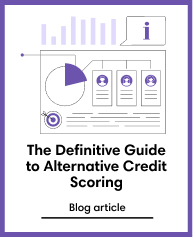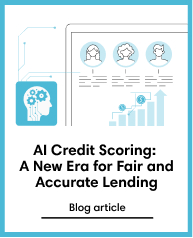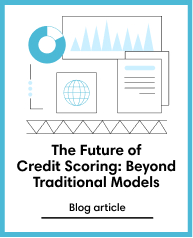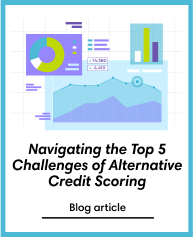Credit Scoring
Oct 31, 2025
Credit Decisioning Process Explained: How To Power Smarter Models with Alternative Data
Subscribe to our newsletter
Credit decision making is a crucial process in financial services, determining who qualifies for loans or credit. Today, smarter and fairer decisions are increasingly possible due to alternative data and machine learning, or ML.
These powerful tools help lenders see a more detailed picture of a person’s financial health, beyond what traditional credit scores show. This improves fairness and accuracy in lending.
Furthermore, it helps more people access credit easily, including those with little or no credit history. This change creates better and more inclusive financial services for everyone.
To understand how this transformation works, we must first understand the foundation: the credit decisioning process itself.
What is Credit Decisioning?
So, what is credit decisioning? In essence, it is the core process lenders use to evaluate potential borrowers. The credit decisioning process refers to how lenders assess a borrower’s application to determine if they can borrow money or obtain credit. It involves reviewing the borrower’s financial information to quickly and fairly assess their ability to repay the loan.
The main purpose of this process is to assess lending risk. It helps lenders determine if someone can repay a loan on time, ensuring they make safe choices and avoid losses.
Good credit decision making also helps borrowers gain fair access to loans based on their financial capability and history. It improves efficiency by speeding up loan approvals and reducing human error.
Factors Influencing Credit Decisioning
The credit decision making process relies on several important factors to decide if a borrower can repay a loan safely. A foundational framework for this is the 5 Cs of credit: Character, Capacity, Capital, Collateral, and Conditions.
The 5 Cs of Credit
- Character assesses the borrower's reliability and past payment history.
- Capacity measures an individual’s ability to repay based on income, expenses, and cash flow.
- Capital shows financial strength or wealth as backup for repayment.
- Collateral refers to assets pledged to secure the loan.
- Conditions include external factors like the economic climate or industry risks.
Other key elements include credit scores, which analyse payment history, debt levels, and credit utilisation. The debt-to-income ratio helps assess borrowing ability without strain, while stable income and employment increase repayment confidence.
The modern credit decision making process also uses alternative data and machine learning to improve accuracy, fairness, and speed of decisions. These advanced tools analyse large datasets to spot risks that traditional methods might miss.
Together, these factors build a more comprehensive picture of a borrower's creditworthiness, helping lenders reduce risk while supporting fair access to credit. This smart, data-driven approach improves outcomes for both lenders and borrowers.
How the Credit Decisioning Process Works
The credit decisioning process follows six key steps to transform an application into a decision. Here is an outline of how it typically works:
- Application submission: The borrower submits personal and financial details needed to apply for credit or a loan. This information forms the foundation of the credit evaluation process.
- Data collection and verification: The lender gathers data from credit bureaus, bank records, and other sources to verify it for accuracy. This ensures the assessment reflects the borrower’s true financial situation.
- Risk assessment: The lender analyses key financial indicators, like credit scores, income, debts, and repayment history, to evaluate the borrower’s risk levels. This step identifies potential red flags and gauges their ability to repay.
- Credit scoring and rule application: The models assign a credit score and apply business rules, such as minimum score requirements, to refine the evaluation. This helps standardise decisions and maintain consistency across applicants.
- Decision outcome: The application is approved, declined, or flagged for further review. These decisions include clear reasons for transparency, and communicating them enhances trust-building and regulatory compliance.
- Feedback and updates: The models and rules are regularly reviewed and updated to maintain accuracy and adapt to changing market conditions. Continuous improvement maintains effectiveness and fairness over time.
This structured process helps lenders make more informed, fairer, and faster decisions while minimising risk. Automated systems now also speed up these steps, improving customer experience and consistency across evaluations.
Limitations of Traditional Credit Decisioning Models
Traditional credit decisioning models have limitations because they heavily rely on past credit history and financial statements, which can be scarce or missing for thin-file or underbanked applicants. This makes it difficult for these models to accurately assess the creditworthiness of many potential borrowers.
- Underbanked individuals often lack extensive financial records, leaving only a few data points for evaluation.
- Traditional models use only backwards-looking data, which may not accurately reflect the applicant’s current or potential financial condition.
- Traditional models also lack the ability to process alternative data, such as behavioural data or mobile phone bills, which could provide a more comprehensive picture of credit risk decision making. As a result, these applicants face higher chances of being declined or unfairly assessed.
These limitations, in turn, limit access to credit, especially for those with non-traditional financial lives. Overall, traditional credit models offer limited predictive power and fairness for these groups, creating a barrier to financial inclusion.
What is Alternative Data in Credit Decisioning?
Alternative data in credit decisioning refers to non-traditional information used to assess a borrower’s creditworthiness. Unlike standard credit reports, it looks beyond past loans and credit cards. This data helps lenders understand and evaluate individuals who lack an extensive credit history, providing a broader and more accurate view of their financial behaviour.
Sources of Alternative Data
- Mobile metadata: Device and app usage patterns that indicate financial stability.
- Telco data: Payment histories and phone usage details from telecom companies.
- Utility payments: Regular payments for electricity, water, and gas bills.
- Behavioural data: Financial habits from online shopping, bill payments, and browsing behaviours.
Alternative data is key to making credit more accessible to thin-file, underbanked, or credit-invisible individuals.
It helps reduce bias and improve fairness in lending decisions by filling gaps that traditional credit data misses. This approach promotes financial inclusion and smarter risk assessments.
Moreover, alternative data enables lenders to detect nuanced financial behaviours, reduce defaults, and approve more loans. As a result, lenders further expand their customer base while adhering to growing regulatory standards.
Credit Risk Decisioning with Machine Learning
Machine learning improves credit risk decision making by uncovering hidden patterns in large and complex data that traditional methods often overlook. This allows lenders to get more accurate risk scores by looking at many factors together.
These models also process alternative data, like behavioural data or transaction history, allowing lenders to better assess borrowers with limited or no credit records.
Machine learning also reduces human bias by using data-driven patterns for decisions, helping to create fairer, faster, and more flexible credit decisions.
Another benefit is that it helps lenders spot risky borrowers early, automate difficult tasks, improve fraud detection, and enforce regulatory compliance. It can help them adjust credit limits based on changing customer behaviour.
Benefits of Using Alternative Data in Credit Decisioning
Alternative data brings several commercial benefits to lenders. Some of these are mentioned below.
- Increases revenue by expanding credit access to underbanked and thin-file borrowers.
- Broadens customer base by opening up new markets.
- Improves risk assessment by utilising more diverse information and making more informed lending decisions.
- Reduces loan defaults and losses by identifying creditworthy applicants overlooked by standard data.
- Increases customer satisfaction by leveraging alternative data to enhance approval rates..
- Speeds up decision-making by enabling faster data collection and analysis.
- Enforces regulatory compliance by providing transparent insights into borrower risk profiles.
Overall, it enhances efficiency, accuracy, and fairness while supporting a more inclusive financial ecosystem, making lending more profitable and sustainable.
Best Practices for Credit Decisioning with Alternative Data and Machine Learning
Clear goals and reliable data are the key to good credit decisioning with alternative data and machine learning. By adopting these best practices, lenders can make more informed, efficient, and accurate credit decisions while effectively minimising risks.
- Define objectives and criteria: Clearly define objectives and set precise, consistent criteria based on risk tolerance and business goals.
- Ensure data quality: Prioritise accurate and reliable data from both traditional and alternative sources. Conduct regular audits to identify and correct errors, and integrate advanced data aggregation tools to streamline this process.
- Design for scalability and flexibility: Use cloud-based solutions to manage application volumes. Keep models updated to adapt to changing consumer behaviour, regulations, and business strategies.
- Leverage explainable machine learning models: Employ explainable machine learning models to maintain transparency. This allows stakeholders to understand credit decisions better and enables human oversight for complex cases.
- Monitor and update model performance: Continuously monitor model performance. Regularly review and update models based on analytics, emerging trends, and bias audits to promote fairness and accuracy.
- Maintain compliance and ethical standards: Ensure compliance with evolving regulatory requirements and adhere to ethical guidelines for the use of customer data.
- Strengthen security measures: Use strong protections against cyber threats and verify identities to prevent fraud and strengthen security.
Technological Improvements in Credit Decisioning
Modern technologies improve the credit decisioning process by automating and streamlining lending workflows. This leads to faster, more accurate, and consistent decisions.
Key technologies driving this improvement include:
- Credit decisioning platforms: Serve as the backbone, enabling lenders to set precise criteria and efficiently process applications.
- APIs and SDKs: Allow seamless integration with external tools and data sources, enriching borrower profiles with alternative data and real-time information.
- Scoring engines: Analyse complex data using advanced algorithms, including machine learning, to generate predictive and adaptive risk scores.
- Integrations (e.g., Credolab): Provide unique access to behavioural insights, enhancing credit evaluations for underbanked and thin-file applicants.
Together, these technologies reduce manual errors, boost operational scalability, and ensure transparency with explainable models. This leads to better risk management, improved customer experience, and sustainable revenue growth.
How Credolab Enhances Credit Decisioning Accuracy
Credolab’s SDK and machine learning engine use real-time device and behavioural metadata to improve credit decision management without causing friction for borrowers. By analysing mobile phone usage patterns, payment behaviours, and transaction data, Credolab captures insights that traditional credit reports may miss.
The SDK integrates seamlessly into existing lending platforms, allowing quick data collection without disrupting the user experience. Its machine learning models process this data instantly to generate more accurate and predictive risk scores.
Credolab’s technology enables lenders to expand credit access, reduce defaults, and improve approval rates. Overall, it offers a smarter, more inclusive way to evaluate creditworthiness by blending advanced analytics with seamless integration into loan applications.
Conclusion
The modern credit decisioning process is evolving rapidly with the integration of alternative data and machine learning. Financial institutions benefit by gaining faster, more accurate, and fairer risk assessments.
Alternative data expands access to credit for underbanked and thin-file applicants. Machine learning models adapt and learn from new data, improving decision outcomes over time.
Together, these technologies enhance operational efficiency, reduce defaults, and boost revenue. This evolving approach enables lenders to make more informed decisions, promoting financial inclusion and regulatory compliance.
FAQs
What is the ideal credit decision-making process?
The ideal credit decision-making process is quick, fair, and accurate. It uses clear rules and good data to decide if someone can repay a loan safely.
What are the 5 C's of credit?
The 5 C's of credit are Character, Capacity, Capital, Collateral, and Conditions. These help lenders check a borrower’s trustworthiness and ability to repay.
What is credit decisioning in banking and lending?
Credit decisioning is the process banks and lenders use to decide if they should give a loan or credit. It looks at a person’s financial details to assess risk.
What role does alternative data play in credit decisioning?
Alternative data gives extra information beyond traditional credit records. It helps lenders see the full financial picture, especially for people with limited or no credit history.
How is machine learning used in credit risk decision making?
Machine learning finds patterns in big data to predict loan risks better than old methods. It helps lenders make faster and fairer credit decisions.





